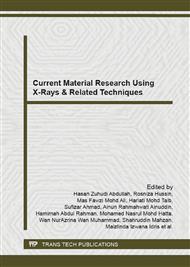p.282
p.287
p.293
p.299
p.304
p.309
p.316
p.321
p.329
The Effect of Ligands on CdSe Nanoparticle Films Deposited by EPD
Abstract:
Nanoparticle from group II-IV semiconductor nanoparticles is widely studied for solar cells. The ability to modify the surface of nanoparticle is significant to successful use in various applications. In this research, mercaptoundecionic acid (MUA) and trioctyl phosphine oxide (TOPO) were used as ligand for cadmium selenide (CdSe) nanoparticles. The wavelength shift to a shorter value observed due to decreasing size of CdSe nanoparticle after ligand exchange from TOPO to MUA. The electrophoretic deposition methods (EPD) have being employed to deposite CdSe nanoparticles films on fluorine doped tin oxide (FTO). The deposition voltages used are between 100 - 400 V for 15 minutes. From SEM results show the formation layer of CdSe nanoparticles capped with MUA is strong and porous as compared to CdSe nanoparticle capped with TOPO. MUA capped CdSe shows better cell efficiency compared to TOPO capped CdSe which is 0.1735 %.
Info:
Periodical:
Pages:
304-308
Citation:
Online since:
February 2015
Authors:
Keywords:
Price:
Сopyright:
© 2015 Trans Tech Publications Ltd. All Rights Reserved
Share:
Citation:


